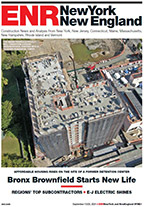Canada-New York Power Line Developer Seeks EPC Contractor
Champlain Hudson Power Express, which got a federal green light on Oct. 1 to build and operate a 1,000-MW, high-voltage transmission line that would run from Canada through New York State and into New York City, now seeks an EPC contractor and additional financing for the estimated $2.2 billion project.
The direct-current line would bring hydro and wind-generated power from Quebec into a constrained area of the Big Apple that also faces the closure of the 2,000-MW Indian Point nuclear plant in Buchanan, N.Y.
It was granted a presidential permit by the U.S. Energy Dept.
The 336-mile new line would terminate in the city's Astoria, Queens section, where it would be converted to alternating current at Consolidated Edison’s Rainey substation.
The planned line would run under Lake Champlain and the Hudson, Harlem and East Rivers, with portions on land buried in highway and railroad right of ways.
According to the company, the line would be routed on land to avoid the area of the Hudson where PCB dredging now is ongoing.
Donald Jessome, CEO of Transmission Developers, the parent of Champlain Hudson Power Express, said in an Oct. 2 interview that Army Corps of Engineers approval is expected this month, noting that DOE and the Corps are looking at many of the same issues. “There was a lot of overlap,” he said.
Transmission Developers, meanwhile, has been working to line up its EPC contractor and financing, which would be traditional project financing, Jessome said.
The Albany-based firm intends to start construction next year, with construction expected to take four years and create about 300 job, it said.
The project already has equity financing from its primary investor, Blackstone Group. Private equity firm BlackRock Group made the initial investment in the project in 2008. Blackstone took over as primary investor in 2010.
The permit issued by DOE includes conditions that require the developer to address concerns raised by the U.S. Coast Guard, American Waterways Operators and others.
In comments on a final environmental impact statement issued in August, they registered opposition to the permit unless the transmission cable is buried to avoid anchor snags.
DOE directed the company to do a revised navigation risk assessment in consultation with the Coast Guard and involve the service in its preparation of an environmental management and construction plan to address the final location and design of the cable.
The final EIS also included environmental mitigation measures that Champlain Hudson will have to implement, DOE said.
The agency said it granted the permit based on consideration of power supply reliability under normal and contingency conditions, and favorable recommendations from the State and Defense Depts.
Transmission Developers also is working on the New England Clean Power Link project, a 1,000-MW HVDC line that would bring power from Canada under Lake Champlain for about 100 miles and into Vermont at Ludlow where it would connect to the VELCO transmission grid and serve the New England market.
That project is looking to secure state and federal permits by year end and come on line in 2019.
Jessome said that both of its projects are designed to bring low-cost energy into constrained markets in the Northeast. New York City in particular is hampered by high demand in an area where it is difficult to build new power projects or transmission lines.
Lower New York is further threatened by the possible closure of Entergy’s 2,000-MW Indian Point nuclear plant in Buchanan. Governor Andrew Cuomo has said he wants to close the plant. The state is looking for alternative sources of generation to offset that risk.
In addition, New York Independent System Operator recently implemented a new capacity zone in the Lower Hudson Valley, the region directly north of New York City, as a means of boosting capacity payments in the hope of attracting investments in new generation.
The new capacity zone has proved to be controversial, and is being contested by several parties.
An appeal is now pending before the 2nd US Circuit Court of Appeals (Central Hudson Gas & Electric v. FERC, 14-1786).




